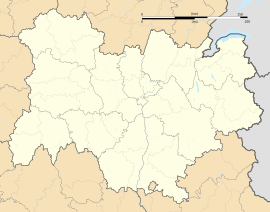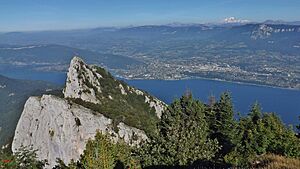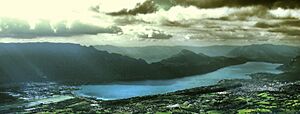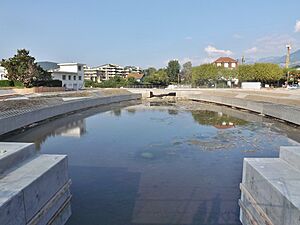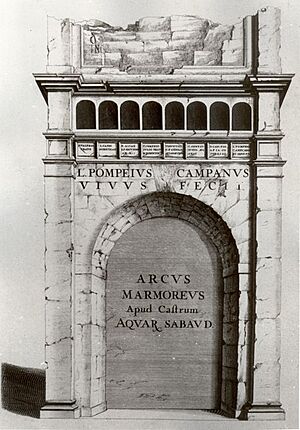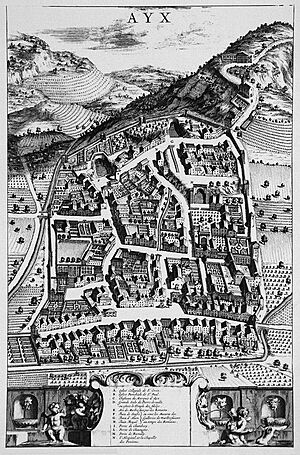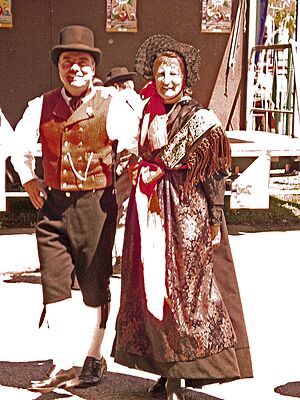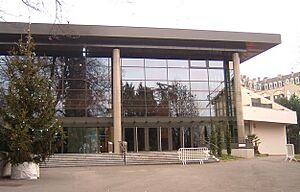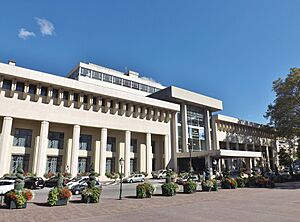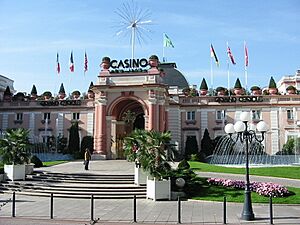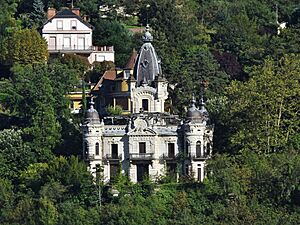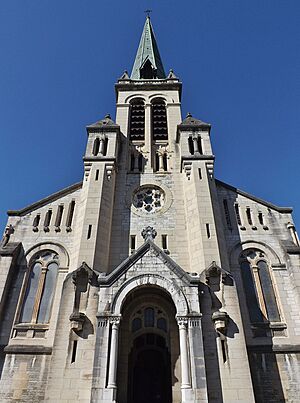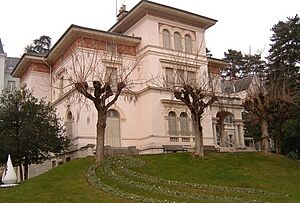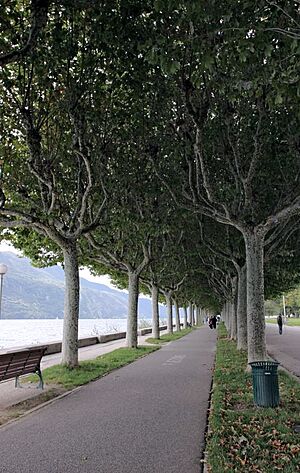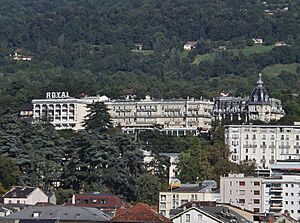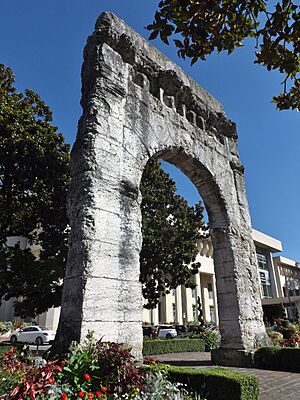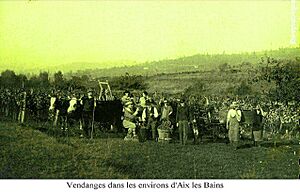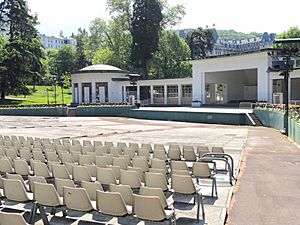Aix-les-Bains facts for kids
Quick facts for kids
Aix-les-Bains
Èx-los-Bens (Arpitan)
|
||
|---|---|---|

Aix-les-Bains on Lake Bourget
|
||
|
||
| Country | France | |
| Region | Auvergne-Rhône-Alpes | |
| Department | Savoie | |
| Arrondissement | Chambéry | |
| Canton | Aix-les-Bains-1 Aix-les-Bains-2 |
|
| Intercommunality | CA Grand Lac | |
| Area
1
|
12.62 km2 (4.87 sq mi) | |
| Population
(2021)
|
31,874 | |
| • Density | 2,525.7/km2 (6,541.5/sq mi) | |
| Time zone | UTC+01:00 (CET) | |
| • Summer (DST) | UTC+02:00 (CEST) | |
| INSEE/Postal code |
73008 /55344
|
|
| Elevation | 224–524 m (735–1,719 ft) (avg. 320 m or 1,050 ft) |
|
| 1 French Land Register data, which excludes lakes, ponds, glaciers > 1 km2 (0.386 sq mi or 247 acres) and river estuaries. | ||
Aix-les-Bains (pronounced "Aks-lay-Ban"), often just called Aix, is a town in southeastern France. It's located in the department of Savoie.
This town sits right on the edge of Lac du Bourget, which is the biggest natural lake in France. Aix-les-Bains is famous as a spa town because of its natural hot springs. It also has the largest freshwater marina in France, where many boats are docked.
Aix-les-Bains is the second-largest city in Savoie. About 31,100 people lived there in 2020. It's part of the larger Chambéry urban area.
Long ago, during a time called the Belle Époque (meaning "Beautiful Era"), Aix-les-Bains was a very popular vacation spot. Rich and royal families from all over the world came to enjoy the thermal baths. Today, while the hot springs are still there, the town attracts visitors for exciting water sports and other activities. It gets up to 200,000 visitors every year. Aix-les-Bains is also a place where some big companies have factories, like General Electric and Aixam, which makes small cars.
Besides its spas and tourism, Aix-les-Bains is known for the national Musilac music festival. The town is also recognized for its beautiful flowers and gardens. It has won awards like the "City of Art and History" label.
Contents
- Exploring Aix-les-Bains' Geography
- Getting Around Aix-les-Bains
- Town Layout and Homes in Aix-les-Bains
- Aix-les-Bains: What's in a Name?
- A Glimpse into Aix-les-Bains' Past
- Sister Cities of Aix-les-Bains
- People and Life in Aix-les-Bains
- Aix-les-Bains' Economy
- Aix-les-Bains: Culture and History
- See also
Exploring Aix-les-Bains' Geography
Where is Aix-les-Bains Located?
Aix-les-Bains is in the southeast of France, about 107 kilometers (66 miles) east of Lyon. The town is nestled between Mont Revard mountain to the east and Lac du Bourget to the west. This means the city mostly stretches from north to south.
The town covers an area of 12.62 square kilometers (4.87 square miles). It's usually thought of in two parts: the lower town by the lake and the upper town, where the main town center is. The town was first built on higher ground to avoid floods from the lake. The average height of the city is about 320 meters (1,050 feet) above sea level. The lowest part, by the lake, is around 224 meters (735 feet).
Aix-les-Bains is right on the shore of Lac du Bourget, which is a large lake. Rivers like the Tillet and the Sierroz flow into the lake from the Aix area. You can see local fish at the town's aquarium. The lake shore is very developed with roads, a railway, restaurants, and nightclubs.
There's a big water sports complex by the lake. It has a swimming pool and a beach with an Art Deco entrance from 1936. A large open area, called an esplanade, is perfect for walking. It offers amazing views of the lake and the Dent du Chat mountain. You can also spot birds like mute swans, mallards, and grey herons there.
The esplanade has two main ports: the Grand port and the Petit port. Together, they form the largest fresh water port in France, with 1,500 places for boats. This is a great spot for boating on the lake. An annual yachting festival takes place here, featuring old boats and shows.
Neighboring Towns Around Aix-les-Bains
Aix-les-Bains shares its borders with nine other towns. To the north is Brison-Saint-Innocent. To the northeast, you'll find Grésy-sur-Aix. East of Aix are Pugny-Chatenod and Mouxy. To the southeast, it borders Drumettaz-Clarafond. South of Aix are Viviers-du-Lac and Tresserve.
Across the lake to the west, Aix-les-Bains borders Bourdeau and La Chapelle-du-Mont-du-Chat. The lake itself forms a natural boundary with five other towns: Bourdeau, Brison-Saint-Innocent, La Chapelle-du-Mont-du-Chat, Tresserve, and Viviers-du-Lac.
Aix-les-Bains Climate Overview
Aix-les-Bains has an oceanic climate, but it's also influenced by its location near several mountain ranges. This means it has warm summers and cool winters. The mountains include the Jura mountains, Bauges, and Bornes Massif.
Getting Around Aix-les-Bains
Roads and Railway Access
Aix-les-Bains is on a main route between Chambéry and Annecy. The A41 motorway runs east of the town. This road connects directly to Annecy and then to Geneva. There are two exits (13 and 14) for Aix-les-Bains. Other main roads also pass through or near the town, linking it to nearby areas.
You can also reach Aix-les-Bains by train. It was one of the first European towns to have a railway. Today, the Aix-les-Bains-Le Revard railway station connects the town to Chambéry, Annecy, and Culoz. The TGV (high-speed train) links Aix-les-Bains to Paris in about three hours. The station is a major transport hub, making it easy to travel to and from the town.
Chambéry-Savoie Airport is just south of Aix-les-Bains, near Lac du Bourget. It has flights to many countries, especially in winter for people visiting ski resorts. Several low-cost carrier airlines offer regular flights.
Local Transport in Aix-les-Bains
In the town center, most people use cars. However, traffic can be heavy, especially in summer due to tourists. The town has been improving its roads with roundabouts to help traffic flow better. There are also car parks in the town center for shoppers.
For public transport, there are two main bus routes and sixteen other routes serving the area. These buses are managed by a company called Ondea. During summer, a small tourist train runs between the lake esplanade, the beach, and the town center.
Town Layout and Homes in Aix-les-Bains
How Aix-les-Bains is Built
Most of Aix-les-Bains' life happens on its higher ground. This is where the downtown area and the thermal baths are located. The town grew around these hot springs, which were first used by the Romans. The lower part of the town, by the lake, was once used for farming and fish farms.
Aix-les-Bains has wide boulevards like Robert Barrier Boulevard and President Wilson Boulevard. The streets in the downtown area are narrower. The town has many different neighborhoods, such as Chantemerle, Boncelin, and Marlioz.
As the town grows, it's expanding into nearby areas like Tresserve and Grésy-sur-Aix. This means Aix-les-Bains is becoming part of a larger urban area. The same is happening with Chambéry to the south. Both areas are growing closer together.
Homes in Aix-les-Bains
In 2017, Aix-les-Bains had over 20,000 homes. Most of these (76.2%) were main residences. About 18% of homes were built before 1945, and 30% were built after 1990. Most homes (76.4%) are apartments, while 22.4% are detached houses. More than half of the main homes (52.7%) are owned by the people living in them.
The town also has social housing (HLM), which are homes with controlled rent. In 1999, 15.7% of the homes were HLM. Many homes in Aix-les-Bains are well-equipped. For example, 93.9% have central heating, and 58.5% have a garage or parking space.
Because most of the town is already built up, it's getting harder to build new, larger houses. The areas around the lake and on the hills are becoming full. Many old luxury hotels from the Belle Époque have been turned into apartments.
Future Plans for Aix-les-Bains
The town has several plans to develop new areas. These projects aim to create new business zones to attract companies. They also plan to build new residential areas for people to live in. For example, the Savoie Hexapôle area is being developed with nearby towns like Méry.
A new area called ZAC des Bords du Lac is being built by the lake. It will cover about 15 hectares (37 acres). This project, called Aix–du Lac, will include new homes and businesses.
A wide promenade, 36 meters (118 feet) wide, is being built along the lake. It will have a narrow road for cars, but most of the space will be for walkers, cyclists, and trees. This area will also have new homes and shops.
In 2013, a big project was to restore the Tillet River and create a new harbor for boats at the Petit Port. This work cost 7 million Euros. The project also aims to clean up the Tillet River, which has been polluted. The contaminated soil will be stored safely on-site and used to widen a road.
These changes will also affect traffic. The Petit Port will become a dead-end street. Other roads will be changed to improve traffic flow and create new green spaces.
Aix-les-Bains: What's in a Name?
Aix-les-Bains was founded a very long time ago, in the 1st century AD. Its name comes from the Latin word Aquae, which means "Waters." This is because of its famous hot springs. You can see this in other towns like Aix-la-Chapelle and Aix-en-Provence.
Historians in the 19th century sometimes used different names for the town, but Aquae is the oldest known. The name Aix-les-Bains first appeared in official records in September 1792. Since 1954, the railway station has been called Aix-les-Bains-le Revard.
A Glimpse into Aix-les-Bains' Past
The history of Aix-les-Bains is closely linked to Lac du Bourget and its hot springs. These springs made it one of the most famous spa towns in the world. To understand Aix-les-Bains, we also need to look at the history of the Savoy region.
Aquae: Roman Times in Aix-les-Bains
Historians believe Aix-les-Bains started with its water sources during Ancient Rome times. Before that, there might have been a Celtic settlement. The earliest signs of people living here date back to the 1st century BCE.
In the 1st century AD, Aix was a small Roman town called a vicus. It had a council of ten members and was part of the city of Vienne. Rich citizens lived there and built things like a funeral arch for the Campanii family.
Archaeologists have found a large thermal complex (bath area) near the hot springs. There was also the Arch of Campanus, likely built in the 1st century. Further down, a temple, possibly for Diana, was built in the 2nd century. Remains of a cemetery have also been found.
Even with these discoveries, we don't know much about the daily life of the Gallo-Romans in Aquae. We don't know where they lived or what their main activities were. The town seems to have grown around the thermal baths, which were built and improved over time. The hot springs were the main reason for the town's location.
From the Middle Ages to the Renaissance
Not much is known about Aix-les-Bains after the Roman Empire ended and during the early Middle Ages. The Roman Baths fell into ruin around the 5th century.
Aix-les-Bains is mentioned again in the 9th century. In 1011, King Rudolph III of Burgundy gave the town of Aix to his wife, Ermengarde. She then gave it to the bishopric of Grenoble. This shows that Aix was a small town with a church and farms.
By the end of the 12th century, there were two other parishes (church areas): Saint-Simond and Saint-Hippolyte. The main part of the town was around the priory (a small monastery) near the old Roman temple. Aix was ruled by the Seyssel family, who had a château (castle).
Other villages existed around Aix. In 1561, about 1095 people lived in Aix. Most lived in the main village, but others lived in smaller hamlets like Saint Simond.
In the early 16th century, the old church burned down. The people of Aix asked Claude de Seyssel for help to rebuild it. A new church, called a collegiate church, was built. It had a beautiful Gothic choir. This church was later torn down in 1909 when a new one was built. The stately Château of Aix was also rebuilt around this time.
Aix-les-Bains in the 18th Century
On April 9, 1739, a huge fire destroyed 80 homes in the town center. This was almost half of the town! When rebuilding, the king made sure new rules were followed. Houses had to be two stories tall, and thatched roofs were not allowed.
People in Aix and doctors started to realize how valuable the hot springs were in the early 17th century. Even though the springs had been used since ancient times, they were mostly used in an outdoor Roman pool or by bringing water to homes.
In 1776, King Victor Amadeus III of Sardinia decided to build a modern thermal bath building. This was finished in 1783. This new building helped the town grow a lot. Old houses were cleared to make space around it.
From 1783 until the French Revolution, about 600 patients visited the baths each year. The town's population grew to 1700 people by 1793. In 1783, a public park called le Gigot (now Square Alfred Boucher) was built for visitors to enjoy.
In 1792, French revolutionary troops took over Savoy. The spa baths were used to help wounded soldiers recover. This also helped make Aix famous. The town officially became "Aix-les-Bains." The Revolution also meant that the town no longer owed money to its local lord. This helped the economy grow, leading to more guesthouses, hotels, and restaurants.
The area by the lake also started to develop. A small harbor became a real port, used for shipping goods. This led to more buildings along the lake avenue, outside the town center.
Morocco's Independence Talks in Aix-les-Bains
Important talks for the independence of Morocco happened in Aix-les-Bains in September 1955. At this meeting, the French leader, Edgar Faure, suggested that Morocco could be independent but still work closely with France.
Before this, Morocco was a French protectorate, and its leader, Sultan Mohammed V, was in exile. Many important people from France and Morocco attended the talks. These negotiations were a big step towards Morocco becoming an independent country.
Morocco was officially declared independent on November 6, 1955. In 2005, a special fountain with Moroccan zellige tiles was built in Aix-les-Bains to remember the 50th anniversary of these important talks.
Sister Cities of Aix-les-Bains
Aix-les-Bains is twinned with other cities around the world. This means they have special friendly relationships and often exchange culture and ideas.
People and Life in Aix-les-Bains
Population and Age Groups
As of 2020, about 33.7% of the people in Aix-les-Bains are over sixty years old. This is a higher percentage than the average for France.
The total number of households in Aix-les-Bains in 2020 was 16,467. The average household had 1.85 people. Almost half of the households (49.1%) had only one person.
Schools and Learning in Aix-les-Bains
Aix-les-Bains has many schools for its residents. There are seven public nursery schools and nine public elementary schools. There are also private schools that work with the government.
For older students, there are three public middle schools (collèges): Garibaldi, Jean-Jacques Perret, and Marlioz. There are also private middle schools. Aix-les-Bains has one public high school (lycée) called Lycée Marlioz, which also offers special training programs.
The town also has other places for learning, like a music conservatory.
Fun Events and Festivals
Aix-les-Bains hosts many exciting festivals and events throughout the year:
- The Rock Musilac Festival in July, which is a big music event.
- The Festival Aix Operettes in July.
- The Festival of Clairvoyance in August.
- The Festival of Romantic Nights of the Lac du Bourget in October.
- The Writers in Series Festival in October.
- The Aix-les-Bains Festival of Francophone Scrabble in November.
- The Festival d'Art Lyrique of Aix les Bains in November.
Other events include:
- The Night of the Museums in May.
- The Acquascenies in July.
- The Navig'Aix in August.
- The Biennale Charles Dullin in November.
Sports and Activities
Aix-les-Bains is a very active town when it comes to sports. There are about 82 sports clubs and over 50 different sports you can try. These include waterskiing, taekwondo, tennis, archery, sailing, volleyball, water polo, and handball.
You can also find judo, karate, swimming (with a club called Cercle des nageurs d'Aix-les-Bains), paragliding, petanque, rugby union, athletics, and rowing. There's also basketball, boxing, fencing, football, and golf at the 18-hole Aix-les-Bains international golf course.
Horse racing takes place at the Hippodrome de Marlioz racecourse. This track has hosted races for over a century.
Cycling is also popular. Two races are held in town each year. Aix-les-Bains has been part of the Critérium du Dauphiné cycling race 18 times. The Tour de France has also had stage finishes here many times, including in 1948, 1951, 1954, and more recently in 2001.
The town has sports services like a municipal sports school and a municipal water sports center with a beach and pool.
Between 1949 and 1961, Aix-les-Bains was known for motorsports. The Aix-les-Bains Circuit du Lac was a 2.4-kilometer (1.5-mile) race track by the lake. It hosted races for different car and motorcycle categories.
Local Media and News
The main newspapers in the area are regional dailies like Le Dauphiné libéré. There are also many local newspapers such as La Vie nouvelle and La Savoie.
For radio, besides national stations, you can listen to local stations like France Bleu Pays de Savoie. TV8 Mont-Blanc is a local TV channel that covers the Savoie region. It often features local life in Aix-les-Bains.
Aix-les-Bains' Economy
Aix-les-Bains used to rely mostly on its thermal baths. But since the mid-20th century, it has changed its economy. Now, it focuses a lot on tourism and health. In 2000, the town was recognized as a "France Station Nautique" for its water activities. It also got the "Tourist Resort" label in 2013.
Jobs and Companies in Aix-les-Bains
In 1999, Aix-les-Bains had about 14,086 jobs. The number of jobs has stayed pretty stable. In 2006, about 1,412 people were looking for jobs, with an unemployment rate of 13.7%.
The town has many organizations to help people find jobs and plan their careers.
There are 2,624 companies and institutions in Aix-les-Bains. In 2004, 198 new businesses started here. Many of these businesses are in trade (28.4%), services to individuals (20.6%), and health/social work (16.1%).
Some of the main companies in Aix-les-Bains include Léon Grosse, a construction company, and Aixam, which makes small cars. Other companies include Savoie-Yaourt (yogurt), a mineral water producer, and Areva. The hotel industry has also been growing, with big companies like Accor present.
Shopping in Aix-les-Bains
Aix-les-Bains has nearly 500 shops, mostly in the town center. These shops benefit from the town's location near the lake and mountains, and from the casino. However, shops in nearby towns and larger supermarkets in Chambéry create competition.
The local government is working to help the shops in Aix-les-Bains. They are creating a trade and crafts office, building an internet site, and improving the connection between the lake and the town center.
Spa Treatments (Hydrotherapy)
The hot springs in Aix-les-Bains were known even to the Celts long ago. The Romans built impressive baths here, which were constantly improved. This tradition of baths has continued for centuries. Even King Henry IV of France visited in 1600.
In 1783, a modern thermal hotel was built. These baths later became the National Baths when Savoy joined France in 1860. New buildings were added over the years, and in 1996, the new Thermes Chevalley were opened.
The water travels underground for a long time, reaching a temperature of 46°C (115°F). These waters are rich in calcium, sulfates, and silica. They are used for showers, baths, swimming pools, or even for drinking. The warm waters are good for conditions like rheumatism (joint pain), sciatica, and problems with veins. However, they are not suitable for everyone, especially those with certain heart conditions.
The National Baths of Aix-les-Bains have two main buildings: the Thermes Pellegrini and the Thermes Chevalley.
There's also the Marlioz Spa, located in a 10-hectare (25-acre) park. This spa uses water from springs found around 1850. It's especially good for helping with breathing problems and mouth diseases. It treats conditions like ear infections, rhinitis, sinusitis, and asthma.
In 1986, about 52,000 people visited the spas. By 2005, this number dropped to about 35,200. This is because of changes in how health insurance covers spa treatments. Aix-les-Bains still accounts for about 7% of all spa visitors in France.
Aix-les-Bains: Culture and History
Aix-les-Bains is part of the Savoy region, known for its unique food and history. The town's past as a spa resort during the Belle Époque gave it a rich and varied heritage. Because of this, it is recognized as a "City of Art and History."
Important Buildings and Landmarks
Aix-les-Bains has a rich history, with many important buildings. Seventeen monuments are listed as monument historique (historic monuments). Over 900 buildings are listed in the General Inventory of Cultural Heritage.
Casino Grand-Cercle
The Casino Grand-Cercle is a very important building in Aix-les-Bains. It was opened in 1850 by King Victor Emmanuel II of Italy. The ceiling of one of its rooms has a mosaic made of 3.5 million tiny glass cubes!
When it first opened, the building had a ballroom and rooms for games and reading. Later, in 1899, a 900-seat theatre was added. The Casino Grand-Cercle is one of the top casinos in France based on its earnings from games.
Château of the Rock of the King
The Château of the Rock of the King is a castle built in the 20th century. It sits on a hillside above Aix-les-Bains, overlooking the racecourse and golf course. It was built in 1900.
This château is now a classified historical monument. Its style mixes oriental palaces with the Renaissance castles. The building is about 500 square meters (5,382 square feet) in size. It's surrounded by a thick forest of trees and plants. The château is currently owned by a private owner from another country.
Our Lady Church
The Notre-Dame-des-Eaux Church is in the center of Aix-les-Bains. Its construction began in 1890 and was mostly finished by 1905.
The church is shaped like a cross. Its overall look is inspired by Byzantine art. The green color of its steeple is from the oxidation of its wooden cover. The tower is 55 meters (180 feet) tall. Inside, you can see simple barrel vaults, which are more Romanesque in style.
The Stations of the Cross inside the church came from Spain. The paintings of the Twelve Apostles in the choir are from Italy and date back to the 17th century. The church stands tall on the heights of Aix-les-Bains.
The Faure Museum
The Faure Museum holds a collection of artworks given to the city by Dr. Jean Faure (1862–1942). The museum opened in 1949 in a villa built in 1902.
This museum has the second-largest collection of works by Auguste Rodin in France, with 34 sculptures. It also displays a collection of impressionism paintings. You can see works by famous artists like Corot, Boudin, Cézanne, Sisley, and Degas. It's the second-largest impressionist collection outside of Paris.
Green Spaces and Parks
Aix-les-Bains often wins awards for its beautiful flowers and gardens. It has been a "Town of four flowers" since 1981. In 2012, it won the "Golden Flower" award.
The town has:
- Over 860 bins and planters.
- 6,000 trees in the city center.
- 279 hectares (690 acres) of parks, gardens, and sports areas.
- 125,000 plants, including 45,000 spring bulbs.
The town's gardening center grows about 300,000 plants each year. Aix-les-Bains was the first city in Savoy to use biological pest control for its plants in 2006.
The Parc floral des Thermes has old and rare trees. It also has an outdoor theater with 3,000 seats, where concerts are held in the summer.
The Parc du Bois Vidal is an 18-hectare (44-acre) park in the heart of the town. It has woods, meadows, hiking trails, and a sports park.
The esplanade by the lake stretches along the east shore of Lac du Bourget. It has lawns and trees and is bordered by two marinas. The Musilac festival and the Navig'Aix event happen here every year.
The Corsuet forest is next to Aix-les-Bains and covers about 116 hectares (287 acres). It has many trails for hiking and mountain biking.
The Japanese Garden features a design based on Kanji symbols. It's located on Charles de Gaulle Avenue.
Historic Hotels
Aix-les-Bains has many impressive old luxury hotels. Most of these grand buildings from the Belle Époque have been turned into apartments. However, they still have their beautiful outside designs and grand entrances. Some famous ones include the Beau-site, the Grand Hotel, the Bernascon, the Splendide, the Royal, and the Mirabeau. The Astoria is the only grand hotel still operating as a hotel.
Many large hotels were built in Aix-les-Bains between 1883 and 1914. Important people like Gaudens-Antoine Rossignoli and Jean-Marie Bernascon helped fund these projects. Architects like Antoine Gouy and Jules Pin Sr. designed them.
Some of these famous hotels include:
- The Splendide luxury hotel (1884)
- The Excelsior luxury hotel (1906)
- The Bernascon luxury hotel (1909)
- The Royal luxury hotel (1914)
- The Mirabeau luxury hotel (1910)
- The Grand Hotel (1858)
- The Hotel of the Globe (1868), now Hôtel de l'Europe
- The Beau Site Hotel (1883)
- The International Hotel (1893)
- The Hôtel des Iles Britanniques (1903)
- The Astoria Hotel (1904)
- The Panoramic Hotel
Other Notable Buildings
Aix-les-Bains has many other historic buildings. From the Gallo-Roman era, there is the Arc funéraire romain de Campanus (Roman funerary Arch of Campanus). This arch was built to honor the dead of the Campanii family. It is over 9 meters (30 feet) tall.
You can also see the impressive Thermes antiques (ancient baths). The Romans built these comfortable baths around 120 BC. They had hot, warm, and cold baths, all covered in marble. The rooms were decorated with columns and sculptures. Today, you can still see these Roman ruins inside the modern National Baths.
The current Aix-les-Bains town hall was once a mansion and then a castle. Next to it is the Gallo-Roman temple, known as the Temple de Diane (Temple of Diana). This ancient temple is one of only three fully preserved temples in France. It is now the Archaeological Museum, holding statues, ancient objects, and items from the Bronze Age.
Local Food (Gastronomy)
The food in Aix-les-Bains is typical of the Savoy region. It uses local ingredients from the mountains and meadows. Besides the famous fondue, you can try potato doughnuts, crozets (small pasta squares), péla (a potato and cheese dish), and tartiflette (a potato, bacon, and cheese gratin). For dessert, there are bugnes (fried pastries) and blueberry pie.
Aix-les-Bains also has many delicious Savoy cheeses like Abondance, Beaufort, and Reblochon. Because of Lac du Bourget and local rivers, fresh water fish are also popular. You can enjoy local trout, Arctic char, and vendace. Pike is also a local favorite.
The nearby forests and mountains, like Mont Revard, offer wild foods like mushrooms. Many vineyards around Aix-les-Bains produce wines used in local dishes, especially white wine for fondue.
Cultural Places
Aix-les-Bains has several places for cultural activities. The Casino Grand-Cercle has a beautiful Théâtre (theater) with 900 seats. It's a masterpiece from the 19th century and is sometimes used for filming.
There's also an outdoor theater called the Théâtre de verdure in the Parc Floral des Thermes. It can hold 3,000 people for outdoor concerts and events. The convention center of Aix-les-Bains hosts exhibitions, concerts, and other cultural events.
Aix-les-Bains was one of the first French cities to have a cinema. Today, it has three cinemas: the Victoria, the Rex, and Les Toiles du Lac. The Les Toiles du Lac is a multiplex with eight screens. The Victoria will focus on showing original and art films.
The Musée Lapidaire is in an old Gallo-Roman temple of Diana. It's now an archaeological museum with statues, ancient objects, and items from the Bronze Age. The Lamartine Municipal Library is a large library named after the poet Alphonse de Lamartine.
Several local history groups are active in Aix-les-Bains. These groups study the region's history and cultural heritage.
Famous People from Aix-les-Bains
Many famous people were born or lived in Aix-les-Bains:
- Victor Amadeus III of Sardinia (1726–1796) – built the baths in Aix in 1783.
- Alphonse de Lamartine (1790–1869) – a famous French poet who wrote his poem Le Lac here.
- Alfred Boucher (1850–1934) – a sculptor who lived and died in Aix.
- Jean-Baptiste Charcot (1867–1936) – a French doctor and explorer who owned a chalet in Aix.
- Christophe Lemaitre (1990–) – a French athlete who trains in Aix and became a European champion in running.
Many other famous people visited Aix-les-Bains for its spa treatments:
- Queen Victoria (visited in 1885, 1887, and 1890).
- Empress Sisi (1895).
- King Leopold II of Belgium.
- Aga Khan III (who got married in Aix).
- Queens Emma and Wilhelmina of the Netherlands.
- The American financier J. P. Morgan.
Members of the Napoleon Bonaparte family also stayed in Aix, including Joséphine de Beauharnais and Marie-Louise of Austria.
Many artists, writers, and performers also visited, such as Victor Hugo, Alexandre Dumas, George Sand, Guy de Maupassant, Sarah Bernhardt, Camille Saint-Saëns, Sergei Rachmaninoff, Charles Trenet, Yves Montand, Édith Piaf, and Charles Aznavour.
Aix-les-Bains' Coat of Arms
| The coat of arms for Aix-les-Bains is described as:
Gules (red) with a star of gold at the top center. Not much is known about the exact history of this coat of arms. However, Amadeus IV, Count of Savoy, used a similar design with a star. This might suggest a connection to the early history of the town. The current design was created in the late 19th century by Guido Gonin. Before the French Revolution, the town didn't have its own official coat of arms. |
See also
 In Spanish: Aix-les-Bains para niños
In Spanish: Aix-les-Bains para niños




